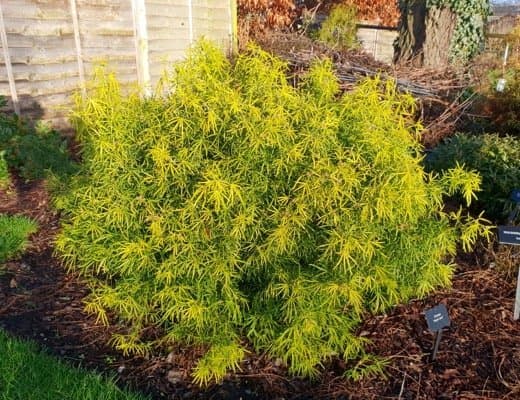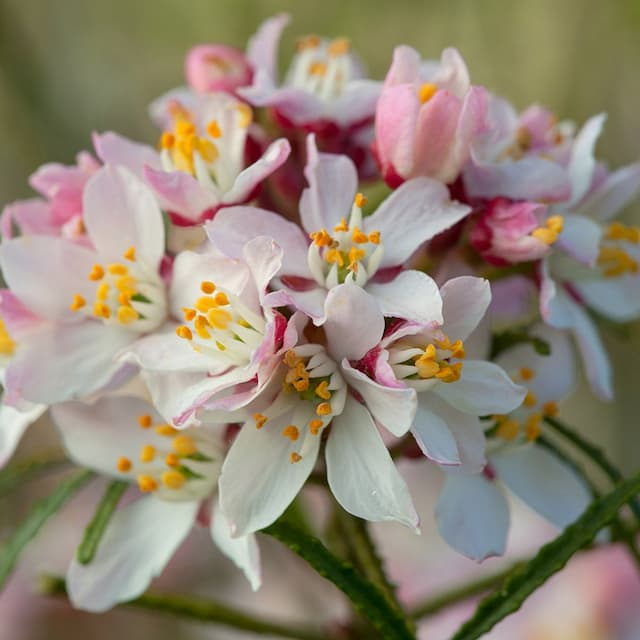Japanese Skimmia Skimmia japonica 'Fragrans' (m)

ABOUT
The Skimmia japonica 'Fragrans', often simply referred to as skimmia, is a striking evergreen shrub that exudes visual and aromatic appeal throughout the year. The most captivating feature of skimmia is perhaps its lush foliage. Each leaf adopts a rich, dark green hue, presenting a glossy sheen on its leathery surface. The leaves are lance-shaped and are elegantly arranged in whorled patterns around the stems, creating a dense and textured appearance. When in bloom, the skimmia produces clusters of small, fragrant flowers. These blossoms are typically white or a creamy shade of white, and they grow in dense panicles, which stand prominently against the dark foliage. Although unimposing in size, the flowers are profuse and emit a delightful fragrance that can be a treat for the senses, especially in the spring months. Following the flowering period, if female plants are nearby for pollination, skimmia is known for its decorative berries. The berries are a bright red or sometimes a deep, wine-red, adding a burst of vibrant color in the fall and winter. They are small, spherical, and grow in dense clusters, providing a striking contrast against the green leaves and making the plant quite ornamental, especially during the colder months when color in the garden is scarce. The overall structure of the skimmia is neat and rounded, with a bushy habit that contributes to its aesthetic appeal. It's a versatile plant, frequently used in garden landscapes to provide evergreen structure, and is equally effective in borders or containers. The skimmia's resilience and year-round beauty make it a popular choice for gardeners looking to enhance their gardens with a low-maintenance yet charming shrub.
About this plant
 Names
NamesFamily
Rutaceae.
Synonyms
Japanese Skimmia, Fragrant Skimmia.
Common names
Skimmia fragrans, Skimmia japonica var. fragrans.
 Toxicity
ToxicityTo humans
Skimmia, specifically Skimmia japonica 'Fragrans', is considered to be mildly toxic to humans if ingested. The plant contains compounds that can be harmful, particularly saponins and alkaloids. When parts of the plant are ingested, potential symptoms of poisoning may include vomiting, diarrhea, and abdominal pain. It is important to keep Skimmia out of reach of children who might be tempted to eat its berries or leaves.
To pets
Skimmia, known as Skimmia japonica 'Fragrans', can be toxic to pets, including dogs and cats, if ingested. The plant contains saponins and alkaloids that can cause vomiting, diarrhea, and abdominal pain. Poisoning can also lead to more serious symptoms such as weakness, reduced appetite, and changes in heart rate. It is advisable to prevent pets from accessing parts of the Skimmia plant to avoid the risk of poisoning.
 Characteristics
CharacteristicsLife cycle
Perennials
Foliage type
Evergreen
Color of leaves
Green
Flower color
White
Height
3-4 feet (0.91-1.22 meters)
Spread
3-4 feet (0.91-1.22 meters)
Plant type
Shrub
Hardiness zones
7
Native area
Japan
Benefits
 General Benefits
General Benefits- Aesthetic Appeal: Skimmia japonica 'Fragrans' is known for its decorative, dense foliage and fragrant blooms that enhance garden aesthetics.
- Seasonal Interest: This plant offers year-round interest, with flowers in spring, berries in autumn and winter, and evergreen foliage.
- Wildlife Attraction: Its berries attract birds, while the flowers are a source of nectar for pollinators like bees.
- Low Maintenance: Skimmia requires minimal pruning and care once established, making it ideal for low-maintenance landscapes.
- Shade Tolerance: It thrives in partial to full shade, providing options for underplanting and filling dark corners of the garden.
- Drought Tolerance: Once established, it can withstand periods of dryness, reducing the need for frequent watering.
- Pest Resistance: Skimmia is resistant to many common pests, lessening the need for chemical treatments.
- Versatility: Can be used in a variety of garden settings, including borders, containers, and woodland gardens.
- Foundation Planting: Its compact growth habit makes it suitable for planting near buildings as part of a foundation planting scheme.
 Medical Properties
Medical PropertiesThis plant is not used for medical purposes.
 Air-purifying Qualities
Air-purifying QualitiesThis plant is not specifically known for air purifying qualities.
 Other Uses
Other Uses- Creating a natural privacy screen: Due to its dense habit, Skimmia japonica 'Fragrans' can be used to create a low maintenance privacy screen in gardens.
- Winter garden interest: The evergreen leaves and red berries (on female plants) provide color to an otherwise barren winter landscape.
- Container planting: Because it thrives in containers, it is ideal for patios, terraces, and balcony gardens.
- Floral arrangements: The foliage and berries are used in floral arrangements, particularly in winter when fresh greenery is scarce.
- Topiary or bonsai: In skilled hands, Skimmia japonica 'Fragrans' can be shaped into topiary or grown as bonsai due to its slow growth and attractive foliage.
- Cultural significance: In Japan, the plant might be used for traditional celebrations or as part of Japanese garden design aesthetics.
- Insect deterrent: The aromatic foliage can sometimes help repel certain problematic insects from outdoor living spaces.
- Border edging: Because of its compact nature, Skimmia is often used as an edge plant in landscaping designs.
- Garden texture contrast: Its leathery leaves provide textural contrast in mixed plantings or shrub borders.
- Wildlife habitat: The dense foliage can serve as shelter for birds and beneficial insects within the garden ecosystem.
Interesting Facts
 Feng Shui
Feng ShuiSkimmia is not used in Feng Shui practice.
 Zodiac Sign Compitability
Zodiac Sign CompitabilitySkimmia is not used in astrology practice.
 Plant Symbolism
Plant Symbolism- Protection - Skimmia japonica, commonly known as Japanese skimmia, is often associated with protection due to its evergreen nature and the resilience of the shrub throughout the seasons.
- Longevity - The plant's ability to thrive for many years makes it a symbol of longevity and endurance.
- Self-sufficiency - As a plant that can thrive in shade and doesn't require much care, the Japanese skimmia represents self-reliance and independence.
- Fragrance - Known for its fragrant flowers, Japanese skimmia symbolizes the sweet, often unnoticed, aspects of life, reminding us to appreciate the small joys.
- Purity - The white blooms of the male Skimmia japonica 'Fragrans' are sometimes associated with purity and innocence.
 Water
WaterJapanese Skimmia should be watered moderately, aiming to keep the soil consistently moist but not waterlogged. During the growing season, this typically means watering once every week, depending on the weather and soil conditions. Each watering session should provide enough water to soak the soil around the root zone. This can be roughly equivalent to 1 to 1.5 gallons for a mature shrub. In winter, reduce watering frequency, only watering when the top inch of soil feels dry to the touch.
 Light
LightJapanese Skimmia thrives in partial shade to full shade. It prefers a spot shielded from the harsh afternoon sun, making it well-suited for north-facing gardens or beneath the canopy of taller trees. Bright, indirect light will ensure the best growth and health of Japanese Skimmia, as too much direct sunlight can scorch the leaves.
 Temperature
TemperatureJapanese Skimmia does well in a range of temperatures, but it prefers cooler conditions. The plant can generally withstand temperatures down to about 10°F and can survive in climates where temperatures do not exceed 90°F. The ideal temperature range for Skimmia is between 30°F and 75°F, ensuring appropriate growth and flower production.
 Pruning
PruningPruning Japanese Skimmia is mainly done to shape the plant or remove diseased and damaged wood. It's best to prune in the late winter or early spring before new growth starts. Pruning should be light, as the plant does not respond well to heavy cutting back. Remove any dead or crossing branches to maintain a tidy appearance and promote good air circulation. Pruning every 2 to 3 years is usually sufficient unless the shrub is experiencing issues that require more frequent attention.
 Cleaning
CleaningAs needed
 Soil
SoilJapanese Skimmia thrives in a soil mix that is rich, well-draining, and slightly acidic, with a pH range of 5.5 to 6.5. A good recipe for its soil would be to combine equal parts of ericaceous compost, peat moss, and perlite to enhance aeration and moisture retention.
 Repotting
RepottingJapanese Skimmia plants typically do not require frequent repotting and can be repotted every 2 to 3 years. They prefer to be slightly root-bound, so repot only when necessary into a slightly larger pot.
 Humidity & Misting
Humidity & MistingJapanese Skimmia prefers moderate to high humidity levels but is quite adaptable. Maintaining indoor humidity around 40-50% is beneficial for the plant's health and growth.
 Suitable locations
Suitable locationsIndoor
Place Japanese Skimmia in bright, indirect light with cool temps.
Outdoor
Plant Japanese Skimmia in partial shade with moist, well-drained soil.
Hardiness zone
7-9 USDA
 Life cycle
Life cycleSkimmia japonica 'Fragrans', commonly known as Fragrant Skimmia, begins its life as a seed, which, under appropriate conditions of moisture and temperature, will germinate and establish a root system. The plant then enters a vegetative stage, producing a rosette of evergreen leaves on a compact shrub that can ultimately grow up to 4 feet tall and wide. As it matures, typically by the second or third year, it develops clusters of small, fragrant white or light pink flowers in the spring, which are particularly attractive to pollinators. Following pollination, male plants like 'Fragrans' do not produce berries; instead, they focus energy back into growth and preparation for the next flowering cycle. Throughout the year, the evergreen foliage provides visual interest, with the plant experiencing incremental growth and leaf replacement. Over many years, the plant can become dense and may require occasional pruning to maintain shape and encourage healthy new growth.
 Propogation
PropogationPropogation time
Late Winter to Early Spring
The Skimmia japonica 'Fragrans', commonly known as Fragrant Skimmia, is often propagated by semi-ripe cuttings. The best time for taking cuttings is generally in late summer to early fall, around August to September. To propagate by this method, one should select a healthy, semi-ripe stem and cut a segment approximately 4 to 6 inches (10 to 15 centimeters) long. The leaves on the lower half of the cutting should be carefully removed and the base of the cutting might be dipped in rooting hormone to improve chances of root development. Then, the cutting should be inserted into a container filled with a well-draining potting mix. The pot should be placed in a spot that receives indirect light and kept under conditions of high humidity. Adequate moisture must be maintained without overwatering until the cutting roots, which could take several weeks.









